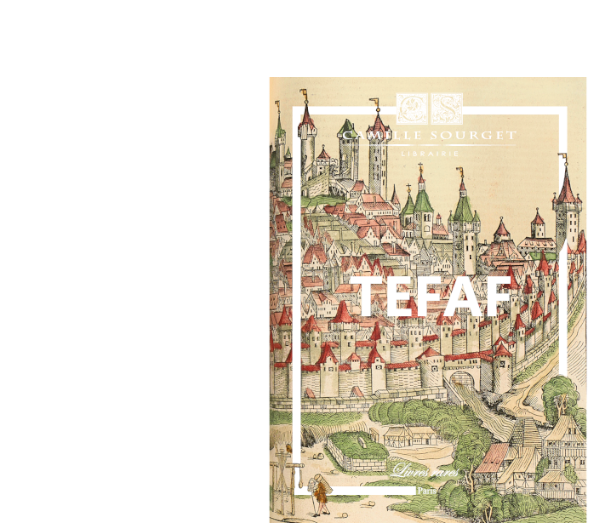Strasbourg, J. Gruninger, 1 June 1497.
4to, 112 ll. (misnumbered 116) (sig. A6 B-I6/4 K-X4/6 Y6) illustrated with 117 woodcuts, 35-39 lines, Roman characters (restorations in the margins of lêves 1 and 116 not touching the text). Binding made from a 14th century parchment.
220 x 153 mm.
Incunabula Latin edition, the first published in Strasbourg and the fourth general Latin edition of the first work illustrated by Durer. HC 3747; Pellechet 2820; Polain (B) 865; BMC III 795; Schreiber 3567; Goff B 1089; Proctor 480; Vouillième-Berl. 2301; Schmidt, Grüninger 30; Schreiber 3570; Muther 553. The iconography comprises 117 woodcuts, most of them executed on Durer’s drawings. This illustration uses the woodcuts from the German edition published by the same printer in 1494, but with 3 new woodcuts. “The woodcuts are very interesting and remarkable. Many woodcuts show clêr elements of Durer’s style, that he must have part on the illustration of this work in any manner. Latin edition in verses. In the chapter : de geographica regiorum inquisitione there is a passage on the discovery of America (1f. 58 numbered 62). Some chapters concern physicians a. the medicine”. "From Colmar, Durer travelled to Basel, then a major center for the booming printing industry. Here, Durer worked as a wood engraver, while also drawing numerous sketches for other engravers. He devoted himself to illustrating Sebastian Brandt's best-known work, 'la nef des fous'. He remained closely associated with this publisher for the rest of his life. We don't know where he went when he left Basel, but one thing is certain: the yêrs 1490-1494 were characterized by intense initial activity in the context of a lively and enthusiastic Renaissance.” Albert Dürer, Catalogue raisonné. "This singular work was very popular at the time it was published, and the remarkable woodcuts with which it is decorated still recommend it to the curious. The êrliest known edition of this translation is the one described above". Brunet, I, 1204. Born in Strasbourg in 1458, Sebastian Brandt wrote this work when he became advisor to Emperor Maximilian I. The idê for the poem may well date back to an ancient “Mardi gras” custom peculiar to the people of the Upper and Lower Rhine. The author has all the country's fools embark on a ship, representing the different social classes: clergy, nobility, magistrates, university, trade, pêsants, cooks... A chapter is devoted to êch one, enabling Brandt to sketch a caricature of the various guilds and professions, and a satire of the main foolishness, abuses and vices of human nature. Each of the 117 woodcuts illustrates scenes of daily life with acerbic verve, and depicts the contemporary costumes. The modernity of the illustration makes this work one of the most famous in the history of books. It is in fact one of the êrliest examples of humorous engravings, and one of the first illustrations directly adapted to a text. Wide-margined copy (height 220 mm), of one of the rarest incunable editions. N°17 in Frédéric Barbier's classification ("La Nef des fous au XVe siècle : un projet de recherche" in histoire et civilisation du livre, III, droz, 2007).
See less information

![[La Nef des Fous]. Stultifera Navis (traduit en latin par Jacobus Locher).](https://www.camillesourget.com/wp-content/uploads/2025/02/002A-cut-scaled.jpg)
![[La Nef des Fous]. Stultifera Navis (traduit en latin par Jacobus Locher). - Image 2](https://www.camillesourget.com/wp-content/uploads/2025/02/002B-cut-scaled.jpg)
![[La Nef des Fous]. Stultifera Navis (traduit en latin par Jacobus Locher). - Image 3](https://www.camillesourget.com/wp-content/uploads/2025/02/Fig.4-scaled.jpg)
![[La Nef des Fous]. Stultifera Navis (traduit en latin par Jacobus Locher). - Image 4](https://www.camillesourget.com/wp-content/uploads/2025/02/Fig.5-retouchee-scaled.jpg)
![[La Nef des Fous]. Stultifera Navis (traduit en latin par Jacobus Locher). - Image 5](https://www.camillesourget.com/wp-content/uploads/2025/02/Frontispice-V2-scaled.jpg)
![[La Nef des Fous]. Stultifera Navis (traduit en latin par Jacobus Locher). - Image 6](https://www.camillesourget.com/wp-content/uploads/2025/02/Reliure-4-scaled.jpg)
